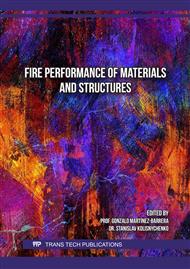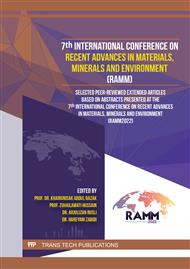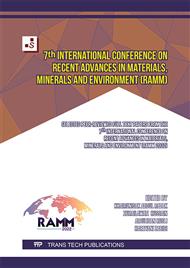[1]
S.‐D. Wang, X.‐C. Pu, K.L. Scrivener, P.L. Pratt, Alkali‐activated slag cement and concrete: a review of properties and problems, Adv. Cem. Res. 7 (1995) 93–102.
DOI: 10.1680/adcr.1995.7.27.93
Google Scholar
[2]
J. Davidovits, Geopolymer: Chemistry & Applications, fifth ed., Institut Géopolymère, Saint-Quentin, France, 2020.
Google Scholar
[3]
P. Duxson, A. Fernández-Jiménez, J.L. Provis, G.C. Lukey, A. Palomo, J.S.J. van Deventer, Geopolymer technology: the current state of the art, J. Mater. Sci. 42 (2007) 2917–2933.
DOI: 10.1007/s10853-006-0637-z
Google Scholar
[4]
J. Davidovits, Geopolymers: inorganic polymeric new materials, J. Therm. Anal. 37 (1991) 1633–1656.
Google Scholar
[5]
S. Luhar, S. Chaudhary, I. Luhar, Thermal resistance of fly ash based rubberized geopolymer concrete, J. Build. Eng. 19 (2018) 420–428.
DOI: 10.1016/j.jobe.2018.05.025
Google Scholar
[6]
Z. Li, Z. Ding, Y. Zhang, Development of sustainable cementitious materials, in: Proceedings of the International Workshop on Sustainable Development and Concrete Technology, Beijing, China, 20–21 May 2004, p.55–76.
Google Scholar
[7]
S. Luhar, S. Chaudhary, I. Luhar, Development of rubberized geopolymer concrete: strength and durability studies, Constr. Build. Mater. 204 (2019) 740–753.
DOI: 10.1016/j.conbuildmat.2019.01.185
Google Scholar
[8]
S. Luhar, T.-W. Cheng, D. Nicolaides, I. Luhar, D. Panias, K. Sakkas, Valorisation of glass wastes for development of geopolymer composites – mechanical properties and rheological characteristics: a review, Constr. Build. Mater. 220 (2019) 547–564.
DOI: 10.1016/j.conbuildmat.2019.06.041
Google Scholar
[9]
S. Luhar, T.-W. Cheng, D. Nicolaides, I. Luhar, D. Panias, K. Sakkas, Valorisation of glass wastes for the development of geopolymer composites – durability, thermal and microstructural properties: a review, Constr. Build. Mater. 222 (2019) 673–687.
DOI: 10.1016/j.conbuildmat.2019.06.169
Google Scholar
[10]
M. Łach, J. Mikuła, W.-T. Lin, P. Bazan, B. Figiela, K. Korniejenko, Development and characterization of thermal insulation geopolymer foams based on fly ash, Proc. Eng. Technol. Innov. 16 (2020) 23–29.
DOI: 10.46604/peti.2020.5291
Google Scholar
[11]
S. Luhar, I. Luhar, Durability properties of green concrete incorporating various waste: a review, J. Mater. Eng. Struct. 6 (2019) 469–484.
Google Scholar
[12]
S. Luhar, U. Dave, Investigations on mechanical properties of fly ash and slag based geopolymer concrete, Indian Concr. J. 5 (2016) 34–41.
Google Scholar
[13]
H. Cheng-Yong, L. Yun-Ming, M.M. Al Bakri Abdullah, K. Hussin, Thermal resistance variations of fly ash geopolymers: foaming responses, Sci. Rep. 7 (2017) 45355.
DOI: 10.1038/srep45355
Google Scholar
[14]
Q. Ma, R. Guo, Z. Zhao, Z. Lin, K. He, Mechanical properties of concrete at high temperature—a review, Constr. Build. Mater. 93 (2015) 371–383.
Google Scholar
[15]
Z. Li, J. Xu, E. Bai, Static and dynamic mechanical properties of concrete after high temperature exposure, Mater. Sci. Eng. A 544 (2012) 27–32.
DOI: 10.1016/j.msea.2012.02.058
Google Scholar
[16]
P.K. Sarker, S. Kelly, Z. Yao, Effect of fire exposure on cracking, spalling and residual strength of fly ash geopolymer concrete, Mater. Des. 63 (2014) 584–592.
DOI: 10.1016/j.matdes.2014.06.059
Google Scholar
[17]
S.N. Abd Razak, N. Shafiq, L. Guillaumat, M.M. Abdul Wahab, S.A. Farhan, N. Husna, F.I. Ismail, Effect of heating duration at high temperature on the strength and integrity of fly ash-based geopolymer concrete, IOP Conf. Ser. Earth Environ. Sci. 945 (2021) 012063.
DOI: 10.1088/1755-1315/945/1/012063
Google Scholar
[18]
BS EN 206:2013, Concrete - specification, performance, production and conformity (+A2:2021), British Standards Institution, London, UK.
Google Scholar
[19]
L. Hou, J. Li, Z.-Y. Lu, Effect of Na/Al on formation, structures and properties of metakaolin based Na-geopolymer, Constr. Build. Mater. 226 (2019) 250–258.
DOI: 10.1016/j.conbuildmat.2019.07.171
Google Scholar
[20]
L. Vitola, I. Pundiene, J. Pranckeviciene, D. Bajare, The impact of the amount of water used in activation solution and the initial temperature of paste on the rheological behaviour and structural evolution of metakaolin-based geopolymer pastes, Sustainability 12 (2020) 8216.
DOI: 10.3390/su12198216
Google Scholar
[21]
S.N. Abd Razak, N. Shafiq, L. Guillaumat, M.M. Abdul Wahab, S.A. Farhan, N. Husna, F.I. Ismail, Fire performance of fly ash-based geopolymer concrete: effect of burning temperature, IOP Conf. Ser. Earth Environ. Sci. 945 (2021) 012062.
DOI: 10.1088/1755-1315/945/1/012062
Google Scholar
[22]
S.N. Abd Razak, N. Shafiq, L. Guillaumat, S. A. Farhan, V. K. Lohana, Fire-exposed fly-ash-based geopolymer concrete: effects of burning temperature on mechanical and microstructural properties, Materials 15 (2022) 1884.
DOI: 10.3390/ma15051884
Google Scholar




